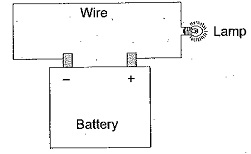Basic Components of Electric Circuit:
The Basic Components of Electric Circuit consists of three parts: (1) energy source, such as battery or generator, (2) the load or sink, such as lamp or motor, and (3) connecting wires as shown in Fig. 1.2. This arrangement represents a simple Circuit Basics, A battery is connected to a lamp with two wires. The purpose of the circuit is to transfer energy from source (battery) to the load (lamp). And this is accomplished by the passage of electrons through wires around the circuit.
The current flows through the filament of the lamp, causing it to emit visible light. The current flows through the battery by chemical action. A closed circuit is defined as a circuit in which the current has a complete path to flow. When the current path is broken so that current cannot flow, the circuit is called an open circuit.
More specifically, interconnection of two or more simple circuit elements and Basic Components of Electric Circuit are namely. voltage sources, resistors, inductors.
If a network contains at least one closed path, it is called an electric circuit. By definition, a simple circuit element is the mathematical model of two terminal electrical devices, and it can be completely characterised by its voltage and current. Evidently then, a physical circuit must provide means for the transfer of energy.
Broadly, Classification of Network Elements divided into four groups, viz.
- Active and Passive
- Unilateral and Bilateral
- Linear and Nonlinear Elements
- Linear and Nonlinear Elements
Active and Passive:
Energy sources (voltage or current sources) are active elements, capable of delivering power to some external device. Passive elements are those which are capable only of receiving power. Some passive elements like inductors and capacitors are capable of storing a finite amount of energy, and return it later to an external element. More specifically, an active element is capable of delivering an average power greater than zero to some external device over an infinite time interval. For example, ideal sources are active elements. A passive element is defined as one that cannot supply average power that is greater than zero over an infinite time interval. Resistors, capacitors and inductors fall into this category.
Unilateral and Bilateral:
In the bilateral element, the voltage-current relation is the same for current flowing in either direction. In contrast, a unilateral element has different relations between voltage and current for the two possible directions of current. Examples of bilateral elements are elements made of high conductivity materials in general. Vacuum diodes, silicon diodes, and metal rectifiers are examples of unilateral elements.
Linear and Nonlinear Elements:
An element is said to be linear, if its voltage-current characteristic is at all times a straight line through the origin. For example, the current passing through a resistor is proportional to the voltage applied through it, and the relation is expressed as V α I or V = IR. A linear element or network is one which satisfies the principle of superposition, i.e. the principle of homogeneity and additivity. An element which does not satisfy the above principle is called a nonlinear element.
Lumped and Distributed Elements:
Lumped elements are those elements which are very small in size and in which the Typical lumped elements are capacitors, resistors, inductors and transformers. Generally the elements are considered as lumped when their size is very small compared to the wave length of the applied signal. Distributed elements, on the other hand, are those which are not electrically separable for analytical purposes. For example, a transmission line which has distributed resistance, inductance and capacitance along its length may extend for hundreds of miles.
